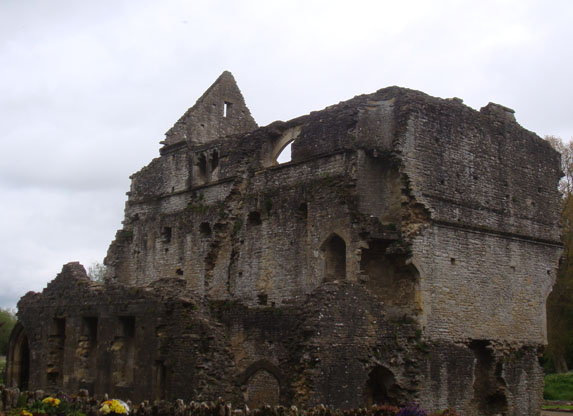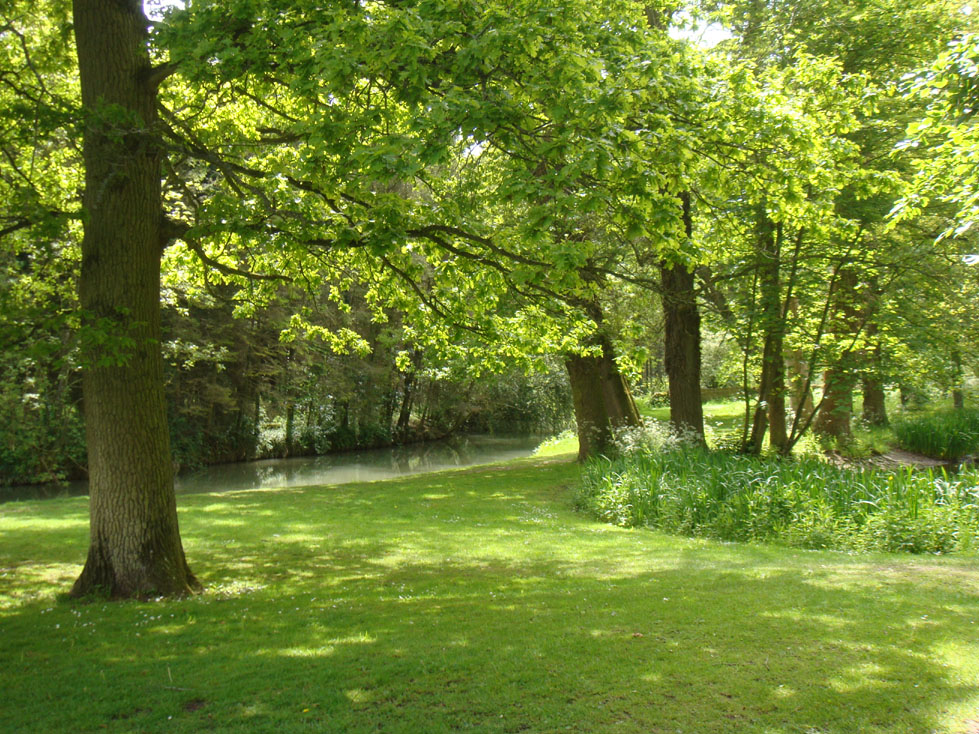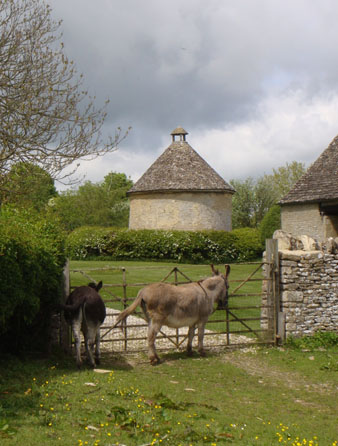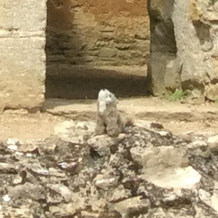
While
Titchmarsh is the place that was and is used to identify this
family and differentiate them from other families with the same
surname, Minster Lovell is the place most widely associated with
the family.1 Minster Lovell is a small village in
Oxfordshire. On the banks of the romantic River Windrush lies
the ensemble of Minster Lovell Hall and Dovecot, and St Kenelm's
Church. The
Hall and Dovecot are in the care of English Heritage.
As a long-time residence of the Lovells, the manor house was continually redesigned and rebuilt to satisfy the changing requirements of a noble family and conform to changing fashions as well. Some remains of earlier buildings have been found in the grounds.
The ruins that can be visited today are what remains of the manor built by William Lovell III in the mid-fifteenth century.

The great hall from St Kenelm's church

The ruins of the great hall as seen from the inner courtyard
Despite these nods to traditional castle architecture, the main purpose of this new hall was to provide a luxurious and comfortable residence for the lord and his family. The windows were decorated with elaborate tracery, a fine path led up to the main entrance, and fireplaces were installed even in the rooms of the attendants of the members of the noble family.

Window with remnants of tracery

The elaborate path to the main entrance
That
William Lovell III decided to have his main residence rebuilt as
a sumptuous, comfortable manor house also tells us something of
his preferences. His grandfather, John Lovell VII, had built an
eccentric, hexagonal tower house in Wardour, which suits his
eccentric status within the Lovell family. William Lovell III's
comfortable home, tucked away in the romantic valley of the
Windrush, far away from the intrigues of the royal court, fits
well with his preference for a quiet country life.

River Windrush

St Kenelm's Church

John Lovell IX
St Kenelm's Church, right next to Minster Lovell Hall, was also built by William Lovell III at around the same time he rebuilt the manor house.4 According to the guidebook of Minster Lovell, the church had been dedicated to St John until the rebuilding.5
Unlike other noble families the Lovells never choose one particular church as the family's mausoleum. All of the Lovells whose burial place is known decreed to be buried in different churches.6 The tomb in Minster Lovell's St Kenelm's Church is, sadly, the only one that has survived to the present day. It is a high quality tomb that can stylistically be dated to the third quarter of the fifteenth century. The tomb statue of a knight in plate armour of fine alabaster, the front of the tomb shows a statue of St Christopher, on one sides are two weepers, the other is decorated with statues of the Virgin Mary and St Margaret.
Taking into account both the fact that the tomb dates from the period between 1450 and 1475 and the fact that William Lovell III was buried in Oxford, it is almost certain that it is John Lovell IX, the father of Francis, Viscount Lovell, who is buried here.

St Christopher between the Lovell and Sydenham coat of arms

The Dovecot
There are two major arguments against this theory: For one, even though Minster Lovell was one of the favourite residences of his family, Francis Lovell had not spend much time there. He would not have had a faithful servant who lived there and was familiar with the locality on whom he could rely on with his life. Additionally, since the place had been granted to none other than Jasper Tudor, uncle of the new king, it must have been just about the last place Francis Lovell would choose to hide. - A more sensible choice would have been, for example, to seek refuge with his mother-in-law. - Secondly, mysterious remains being discovered during some building works that then immediately turn to dust, is a classic tale. In real life, a mummified body would quickly decay when exposed to air, but it would not immediately turn to dust.7
Another intriguing possibility is that Francis Lovell fled to Scotland, as in June 1488 a safe conduct to a 'Lord Luvel' was issued by James IV. According to this theory Francis Lovell lived in his Scottish exile until 1491/92.8 Though this is a possible scenario, I find it hard to believe that Francis Lovell really lived for four years in such obscurity and complete inactivity that no other traces of him can be found in the records. Until the Battle of Stoke, Francis Lovell had been involved in just about all attempts to overthrow Henry VII. Why would he stop now?
In the end, the most likely solution to the riddle of Francis Lovell's disappearance is that he died shortly after the Battle of Stoke.

Kate the Coyote in Minster Lovell
1
The other place bearing the family's name, Upton Lovell
(Wilts.), does not even come as a distant second.
Unsurprisingly, considering that Upton Lovell neither has a
romantic ruin nor a tomb of the family to remind us why it
bears this name.
2 Taylor, Alien Priory, p. 103.
3 Taylor, Minster Lovell Hall (1958), p. 16.
4 Taylor, Alien Priory, p. 114.
5 The booklet is simply called "Minster Lovell", but there's no indication either of the author or the date of publication.
6 John Lovell VII was buried in the Hospital of St. James and St. John in Brackley (Northamptonshire), William Lovell III in the Greyfriars Convent in Oxford.
7 For a different take see D. Baldwin, 'What happened to Lord Lovel?', The Ricardian 7 (1985), 56-65.
8 Sheilah O'Connor, 'Francis Lovell and the Rebels of Furness Falls', The Ricardian 7 (1987), 366-70.
2 Taylor, Alien Priory, p. 103.
3 Taylor, Minster Lovell Hall (1958), p. 16.
4 Taylor, Alien Priory, p. 114.
5 The booklet is simply called "Minster Lovell", but there's no indication either of the author or the date of publication.
6 John Lovell VII was buried in the Hospital of St. James and St. John in Brackley (Northamptonshire), William Lovell III in the Greyfriars Convent in Oxford.
7 For a different take see D. Baldwin, 'What happened to Lord Lovel?', The Ricardian 7 (1985), 56-65.
8 Sheilah O'Connor, 'Francis Lovell and the Rebels of Furness Falls', The Ricardian 7 (1987), 366-70.
Girouard, Mark, Life in the English Country House. A Social and Architectural History (Harmondsworth, 1980).
Lamborn, E.A.G., ‘The Lovel Tomb at Minster’, Oxford Archeological Society Report 83 (1937), 13-20.
Taylor, A.J., ‘The Alien Priory of Minster Lovell’, Oxoniensia 2 (1937), 103-17.
-, Minster Lovell Hall (Oxfordshire)(Ministry of Works, London, 1947).
-, Minster Lovell Hall. Oxfordshire (English Heritage)(1958).
Simon, Monika, 'The Lovells of Titchmarsh. A Late Medieval Baronial Family (1297-148?)', (unpubl. DPhil Thesis, University of York, 1999).
-, 'Who is buried in the Tomb in St Kenelm's Church, Minster Lovell?', The Ricardian 19 (2009), 84-94.
Wood, Margaret, The English Medieval House (London, 1965).
Home